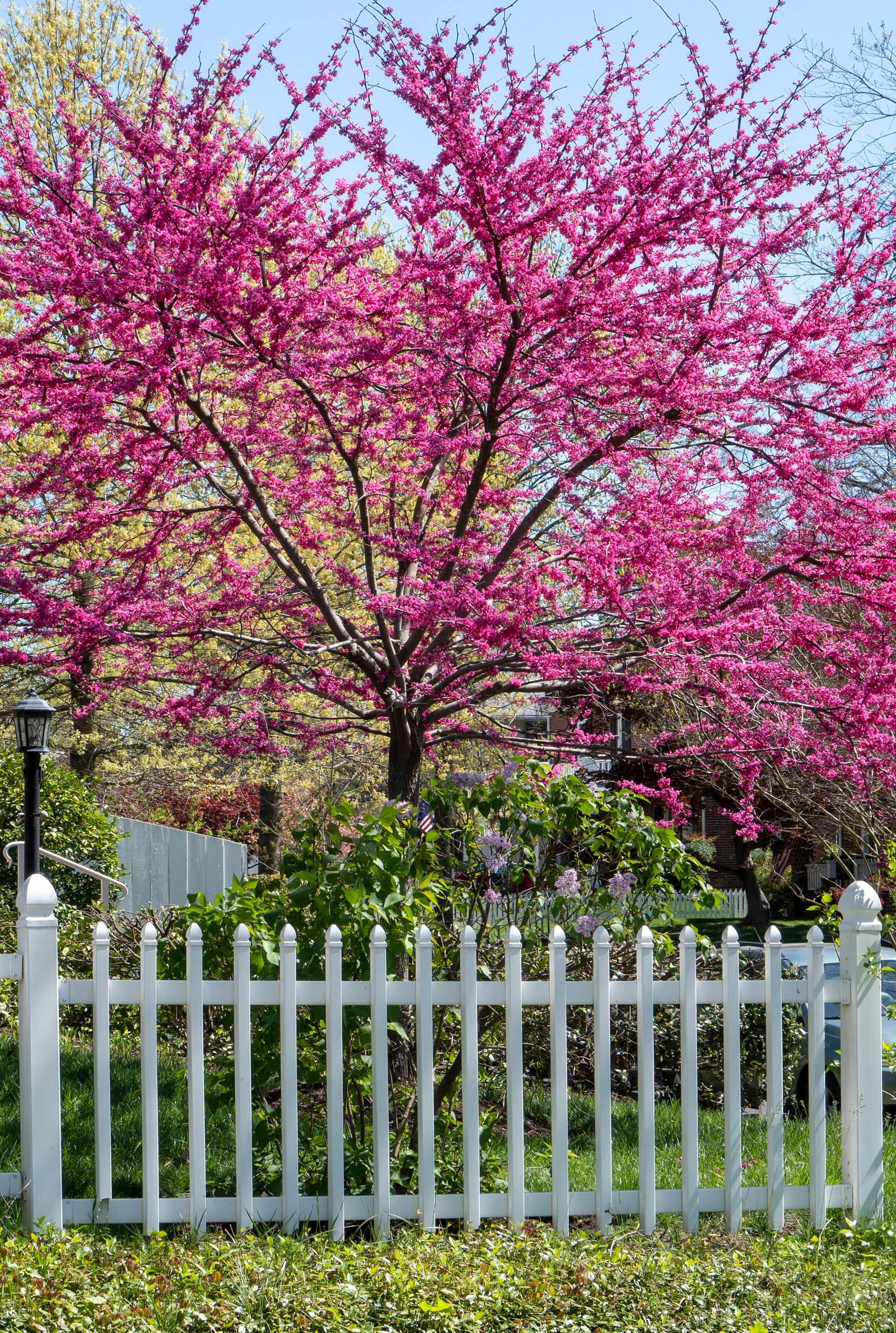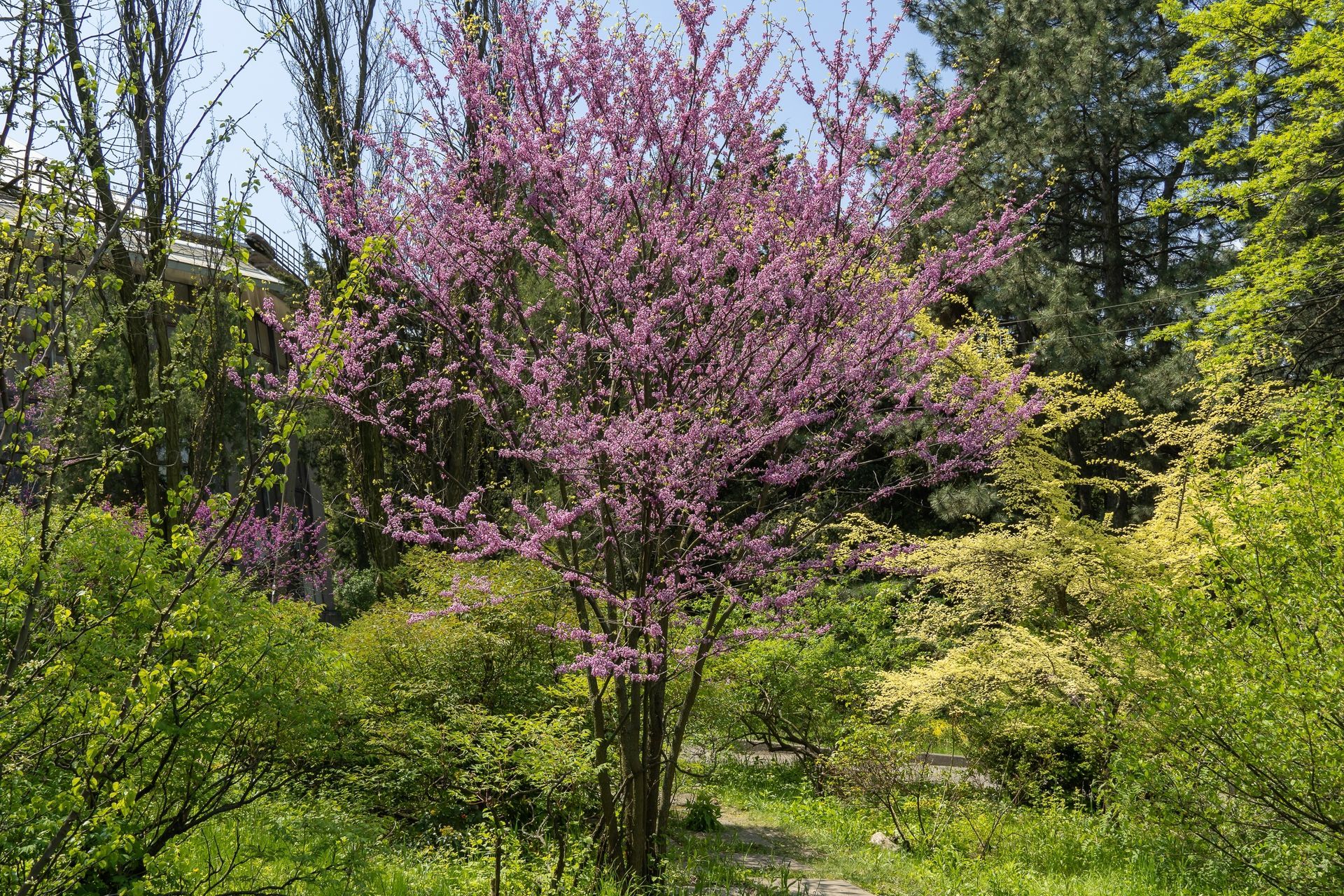Redbud Tree Care

Redbud trees are known for their rosy pink flowers with a dash of purple. These showy flowers develop in spring and form in clusters on the branches.
In the day, redbud tree bark was used to make traditional medicine for whooping cough. Cold infusions of the inner bark and roots were also used to treat congestion and fevers.
Nowadays, most people grow redbud trees for their ornamental value. But before you can marvel at this beautiful tree in your garden, you need to know about redbud tree care.
Fast Facts for Redbud Tree Care
| Common Name | Redbud, Judas Tree |
|---|---|
| Scientific Name | Cercis canadensis |
| Month(s) of Harvest | Late summer or fall months, from July to October |
| Light | Require full sun to partial shade, but eastern redbuds flower best when in full sun |
| Water | Should be watered deeply at least two times a week for the first month, followed by weekly watering for the second and third months of growth |
| Soil | Best grown in loamy, rich, sandy, and well-drained soil |
| Fertilizer | Requires periodic fertilization with a multi-purpose liquid fertilizer |
| Pests | s susceptible to attack by leaf-eating insects, such as tent caterpillars, weevils, leafhoppers, treehoppers, and leafrollers. Branches may be attacked by insects like terrapin, oleander, greedy, and leucanium |
| Diseases | Prone to Asiatic oak weevil, canker, and leaf spots |
| Growing Zone | 4 to 9 |
Table of Contents

Beautiful front yard Redbud Tree
Everything You Need To Know About Redbud Tree Care
Proper redbud tree care ensures your tree reaches its full potential. Here are some critical aspects related to the care of redbud trees.
Soil & Container
Whether you want to grow a forest pansy redbud tree or an eastern redbud, it's crucial to ensure the plant has enough room to grow. Choose a container large enough to accommodate the root system, making sure it has plenty of drainage holes at the bottom.
Alternatively, you can plant your tree in the ground. It will eliminate the need for you to transplant the tree from the pot to the yard when it's big enough.
Since redbud trees are pretty adaptable, they can grow in poor soils too. But they usually prefer well-drained loamy soil, which is slightly acidic or alkaline. The suitable pH for the soil is between 6.5 and 8.
If you're unsure about the native soil drainage in your yard, conduct a soil drainage test. To do this:
- Dig a 12 x 12-inch hole in the ground.
- Fill it with water.
- Let it drain
- Fill it with water again. But this time, set a timer to see how long the hole takes to drain.
You have well-drained soil if the rate decreases by 1 inch per hour. A faster rate indicates sandy or loose soil. In this case, you'll have to add organic matter or topsoil to help the soil retain moisture. Meanwhile, a slower rate makes the soil unfit for eastern redbud growth.
Root Inspection
If you plant redbud trees in a container, you'll have to transplant them into the ground when they are 1-2 years old. Otherwise, the extended root development in a container can stunt the tree's growth.
Before you transplant the tree, make sure to inspect its roots. Look for:
- Broken roots
- Circling roots
- Girdling roots
Remove the dead or broken roots from the root ball. Also, if you see any circling roots, position them so they grow outward from the trunk.
You may have to wash the root ball excessively to reveal these issues.
Water Requirements
Since eastern redbud trees are drought-tolerant, you do not have to water them too often. But when the tree is in its early growth period, it needs more water than usual.
For the first month of your tree's growth, water it until the ground becomes completely wet. Do this thrice a week.
After the first month, water your tree once a week. Do the same in the third month too. Once the tree is established, water it deeply once a week. Look into drip irrigation for trees if you don't want to hand water.
Fertilizing and Filling
An eastern redbud tree doesn't necessarily need to be fertilized. However, you can apply a slow-release fertilizer to your tree if you want it to have more nutrients.
Fill the planting hole with fertilized soil and around 3-4 inches of mulch or compost. Liquid fertilizers are also helpful for supplementing nutrients.
Sun & Placement
When caring for redbud trees, it's imperative to let them get sufficient sunlight since that helps them grow beautiful pink flowers in early spring.
An eastern redbud tree should get at least four to six hours of full sun every day. Additionally, it requires partial shade for the rest of the day.
So, you should place your redbud tree in an area that gets full sun for several hours daily, with some shade during the day.
Temperature and Humidity
The optimal temperature for an eastern redbud tree is 50 to 95 ℉ (10 to 35 ℃). Due to its drought tolerance, the tree can survive dry periods with temperatures above 95 ℉ (35 ℃).
The tree does well in both humid and dry climates. You should cover your tree's base with an inch of mulch to help the soil retain moisture.
Pruning
Here are the must-knows about pruning redbud trees:
- When: The best time to prune eastern redbud trees is in spring after the flowers have bloomed. You can also prune in late winter in the tree's dormancy period.
- Why: Pruning a redbud tree helps maintain a bushy shape and encourages more flowers.
- Tree Cutting Tools: You'll need pruning shears to cut back dead or diseased branches. Other tools you may need include a lopper and a pruning saw.
Now, you can use these tips to prune a redbud tree:
- Remove the dead, crossing, and diseased branches.
- Prune the branches growing too close to each other.
- Remove some lower branches every year if you do not want the tree to have lower limbs when it reaches maturity.
Did You Know? The redbud blossoms look a lot like pea blossoms because both trees belong to the same family, called Fabaceae. Like peas, redbud blossoms can also be eaten. They add a citrusy and bright flavor to your salads. You can also pickle unopened buds and use them as a substitute for the caper.

Redbud Tree Problems
Like any other tree, redbud trees are also susceptible to a host of problems, including pests and diseases. Some common issues these trees experience are discussed below.
Not Flowering
Redbud trees are the first to bloom when spring arrives. If your tree is not blooming, it's likely that it's not mature enough. You should wait at least three to five years for it to become mature enough to bloom.
If the tree is mature and still not blooming, it may be due to the lack of sunlight. Move your plant to a new place where it gets enough sunlight to blossom flowers.
Yellowing Leaves
Redbud trees can survive periods of drought, but extended drought conditions can put stress on the plant's well-being and growth. As a result, you may notice yellowing leaves.
If that happens, your first plan of action should be to water your tree more frequently.
It's also possible that your tree is malnourished. Lack of proper nutrients can result in yellowing of the leaves. Fertilize your tree with a balanced fertilizer to make up for this deficiency.
Wilting Leaves
The most common cause of a redbud tree's leaves wilting is dieback/canker. A canker is a necrotic area on the tree branch or trunk that may be discolored, sunken, or oozing.
When a plant gets weakened due to drought stress, nutritional imbalance, root rot, or insect injury, it becomes prone to canker. The control measures for canker include:
- Removing the diseased parts of the redbud tree
- Growing pest-resistant varieties
- Avoiding overcrowding and overwatering the trees
- Using fertilizers to replenish the nutritional imbalance
Damaged Leaves
Anthracnose is a common reason for damaged leaves on redbud trees. It is characterized by lesion formation on leaves. In several cases, cankers form on the stems and twigs.
Although some pesticides for anthracnose infection are available, they usually have a preventative mechanism of action.
Another disease that affects the redbud leaves is Verticillium wilt. The fungal disease damages the xylem and phloem tissue in a plant, causing leaves to wilt, turn brown, and fall. Branches and shoots also die over time. If the infection persists, the whole tree can die.
The best way to avoid fungal infections, pests, and diseases is to plant resistant varieties of Texas redbud, Chinese redbud, Mexican redbud, or eastern redbud trees.
Learning About Redbud Trees
By now, you should know quite a bit about eastern redbud care. Have you ever wondered how many other redbud varieties there are? Well, too many. We discuss a few below.
Ace of Hearts
The cultivar gets its name from a unique heart-shaped leaf. It has small clusters of bright pink flowers on reddish stems and dark green foliage. The tree grows to about 12 feet tall and has an upright habit.
Avondale
Avondale is a semi-dwarf redbud tree with neon pink flowers that give your yard an instant aesthetic boost.
Black Pearl
Black Pearl's heart-shaped leaves are so purple that they seem black from a distance. The beautiful foliage is coupled with the usual pink and purple spring blossoms. It is an excellent choice for people who prefer larger trees since it grows to about 20 feet tall.
Cascading Hearts
Standing at 8 feet tall, the Cascading Hearts cultivar has a weeping growth habit. Even when it is not blooming, the weeping branches of this tree make it hard for passersby to look away.
Don Egolf
If you're looking for something petite, the Chinese Don Egolf cultivar is just the pick. It has fuchsia flowers that add a pop of color to your garden. Also, the tree keeps a compact shape even if you're not consistent with pruning.
Redbud Origin
Redbud trees are native to Asia, North America, and southern Europe. They were grown for their showy lavender-pink flowers.
There's a folk legend that redbud's flowers that are initially white turn red because of blood or shame. That's how the species got its common name of 'redbud.'
Sweet New Earth's Final Say On Redbud Trees
To sum up the redbud tree care guide, we can say that growing redbud trees is not hard as long as you provide the Judas tree with wet soil, partial shade, and full sun.
Young trees have higher water requirements than their older counterparts. The tree takes about four years to mature and bloom. When the mature tree blooms, it is covered with beautiful pink flowers and looks like something straight out of a fairy tale.
The redbud tree is the perfect addition to any garden, especially if you're looking for something petite with a pop of color and character. It's also an excellent choice for small yards with limited space.

Christina Hernandez
Christina has done most of her research on environmental science but recently has changed her focus towards sustainable forestry. She has a passion for the outdoors and wants to spread that passion to the world.
Join our community!
Join to receive guides, insights, and the latest gardening deals!
